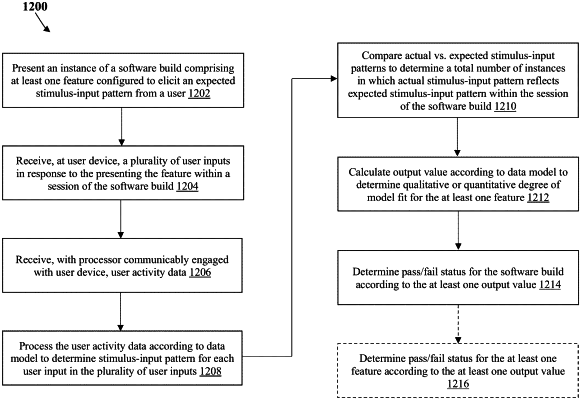| CPC G06F 11/3664 (2013.01) [G06F 11/3688 (2013.01); G06F 11/3692 (2013.01); G16H 20/00 (2018.01)] | 14 Claims |

|
1. A method for software quality assurance, comprising:
presenting, with a user computing device via a user interface, an instance of a software build to a user, wherein the software build comprises at least one feature comprising one or more computerized stimuli or interactions configured to elicit an expected stimulus-input pattern from the user in response to the one or more computerized stimuli or interactions,
wherein the expected stimulus-input pattern comprises a clinically validated stimulus-response pattern for treating or targeting one or more neurological, psychological and/or somatic condition in the user;
receiving, with at least one sensor communicably engaged with the user computing device, a plurality of user inputs in response to presenting the one or more computerized stimuli or interactions within the instance of the software build, the plurality of user inputs comprising user activity data for a session of the software build;
communicating, via a network communications protocol comprising an application programming interface, the user activity data from a first server communicably engaged with the user computing device to a second server, wherein the first server comprises a software development subsystem server and the second server comprises a design control subsystem server;
receiving, at a classification module executing on the second server, the user activity data, wherein the classification module is communicably engaged with a design control subsystem database via a simple notification service or a simple queue service, wherein the design control subsystem database is configured to store the user activity data;
processing, via the classification module, the user activity data to determine one or more actual stimulus-input patterns for each user input in the plurality of user inputs, wherein the classification module comprises a computer-implemented machine learning framework comprising an ensemble learning model or a supervised learning model configured to classify one or more variables between the user activity data and the clinically validated stimulus-response pattern,
wherein the classification module is configured to calculate a degree of conformity between the one or more actual stimulus-input patterns and the clinically validated stimulus-response pattern for treating or targeting the one or more neurological, psychological and/or somatic condition in the user;
comparing, with the second server, the one or more actual stimulus-input patterns for each user input in the plurality of user inputs to the expected stimulus-input pattern for the at least one feature to determine a total number of instances in which the one or more actual stimulus-input patterns was reflective of the expected stimulus-input pattern within the session of the software build;
calculating, with the second server, at least one output value for the user activity data according to the classification module, wherein the at least one output value comprises a qualitative or quantitative degree of conformity between the one or more actual stimulus-input patterns and the expected stimulus-input pattern for the at least one feature;
calculating, with the second server, a measure of net therapeutic activity within the session of the software build according to the total number of instances in which the one or more actual stimulus-input patterns was reflective of the expected stimulus-input pattern within the session of the software build; and
determining, with the second server, a pass/fail status for the software build according to the at least one output value and the measure of net therapeutic activity within the session of the software build,
wherein determining the pass/fail status comprises determining a minimum performance threshold for the session of the software build,
wherein the minimum performance threshold comprises a minimum degree of conformity between the one or more actual stimulus-input patterns and the clinically validated stimulus-response pattern for treating or targeting the one or more neurological, psychological and/or somatic condition in the user, and
wherein the minimum performance threshold further comprises a minimum measure of therapeutic activity delivered to the user within the session of the software build.
|